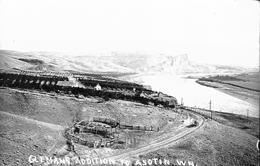On July 2, 1890, the Board of County Commissioners of Asotin County files with the Washington Secretary of State its declaration that Asotin is reincorporated as a municipal corporation of the fourth class under the style and name of the Town of Asotin. The County Commissioners' declaration was issued on June 24, 1890, and certified the results of an election held three days earlier in which voters overwhelmingly approved incorporation and elected a mayor, five councilmen, and a treasurer. The reincorporation comes two years after the community's first attempt at incorporation, and follows a ruling from the Washington State Supreme Court earlier in 1890 that effectively invalidated the incorporation of towns like Asotin that had been accomplished by order of district courts under the territorial government. The Town of Asotin remains the county seat of Asotin County, located in the southeast corner of the newly established state of Washington, as previously authorized by an act of the Washington Territorial Legislature in October 1883.
Two in One
Asotin traces its origins to 1867 when Peter "Jerry" Maguire (1832-1905), a stock raiser, settled in the area around the confluence of Asotin Creek and the Snake River. Most of the Nez Perce Indians who previously lived in Southeastern Washington had moved to North Central Idaho to live within new reservation boundaries defined in the Nez Perce Treaty of 1863. From the late 1860s through the late 1870s, a steady stream of new settlers moved into the area, scattering homesteads across the fertile grasslands along Asotin Creek and its tributaries.
In the spring of 1878, local resident Alexander Sumpter Jr. (1853-1916) and Columbia County Surveyor Alfred T. Beall (1836-?) platted two separate town sites within close proximity of each other along the Snake, which they named respectively Assotin City and Asotin. Both names were variations of the Nez Perce word for the freshwater eel abundant in the creek. The growth of these two towns, whose plats were recorded officially in 1880 and 1881, made them almost indistinguishable within a few years, although Assotin City's growth consistently lagged behind that of Asotin. The two towns joined forces in 1883 to win the election for county seat of the newly formed Asotin County. Assotin City and Asotin officially merged as one town in 1886 under the name Asotin.
Petition to Incorporate
The merger generated public interest in incorporating the town of Asotin, which by this time had a population of approximately 200 people. On May 28, 1888, local citizens assembled in Baumeister's Hall, named for early Asotin businessman and community leader Edward Baumeister (1848-1933), to formalize boundary lines and draft a petition to incorporate. Territorial Judge William G. Langford (1835-1893) approved Asotin's petition to incorporate on June 15, 1888. Langford's order appointed a five-member provisional Board of Trustees, which included Baumeister, D. Talbott , Henry C. Fulton (1852-1935), William J. Clemans (1850-1918), and James N. Rice (1836-1915), and set the first election for April 1, 1889. The results of this election brought in an entirely new slate of trustees: Jacob K. Rice (1830-1921), D. J. Wann, J. H. Bingham, M. B. Mitchell, and James Michie.
Meanwhile, Washington's transition to statehood in 1889 proved right the concerns of Asotin citizens who opposed incorporation in 1888. On February 13, 1890, the new state Supreme Court issued a decision that effectively voided Asotin's incorporation. However, for those who had previously opposed incorporation, the advantages of Asotin's initial incorporation had become evident and the Supreme Court's ruling did nothing to ebb the tide of growing popular sentiment in favor of incorporation. Community leaders thus responded to the court's decision by immediately moving to reincorporate.
Under new state laws, municipal incorporations could be achieved by order of county commissions upon petition. Asotin citizens filed their petition with the Board of County Commissioners on May 29, 1890, to request an election for incorporation. The commissioners approved the petition and set a special election for June 21, 1890. On this date, 34 votes were cast and voters approved Asotin's incorporation 33 to one. They also chose new officers, including Mayor Charles Isecke (1842-1912); Councilmen Edward Baumeister, Hiram E. Benedict (1846-1900), Nicholaus Ausman (1834-1901), Richard Ruddy, and L. B. Howard; and Treasurer Jackson O'Keefe (1851-1907).
On June 24, the county commission issued its order certifying election results for the reincorporation of Asotin and the selection of its officers. The office of the Washington Secretary of State received copies of these proceedings on July 2, 1890, which stands as Asotin's official date of incorporation.
City or Town
The 1890 reincorporation order did not include a charter that clearly outlined Asotin's government structure or schedule for elections. However, the order's listing of municipal election results reveals that Asotin reorganized the Board of Trustees structure that characterized the initial incorporation of 1888 into a mayoral-council plan of government by the time it reincorporated two years later. Subsequent municipal election results listed in early local histories suggest that all officers were elected annually through the early twentieth century. Subsequently, the election schedule changed several times and as of 2015 ran on a four-year cycle.
Although the municipality was incorporated officially as the Town of Asotin, early residents preserved the legacy of the first of the two original townsites by calling their small community the City of Asotin, as it is known today. The original documentation of the Board of County Commissioners proceedings and order to reincorporate Asotin in 1890 are preserved at the Washington State Archives in Olympia while the Asotin County Historical Society in Asotin houses records of the town's earliest explorers and pioneers.

